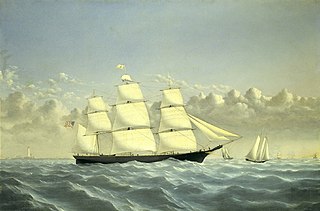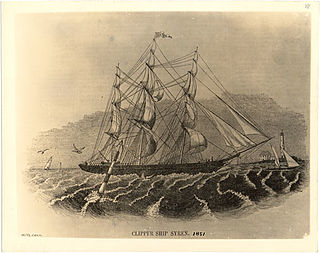
Flying Cloud was a clipper ship that set the world's sailing record for the fastest passage between New York and San Francisco, 89 days 8 hours. The ship held this record for over 130 years, from 1854 to 1989.

Sovereign of the Seas, a clipper ship built in 1852, was a sailing vessel notable for setting the world record for fastest sailing ship—22 knots.

Northern Light was an American clipper ship. In 1853 she sailed from San Francisco, California to Boston, Massachusetts via Cape Horn with Captain Freeman Hatch at the helm in a record-setting 76 days, 6 hours. The record still stands for a single hull vessel. In 1993 the record was soundly broken by a multi-hull sailing vessel Great American II with no cargo. Sailing around Cape Horn is widely regarded as one of the most challenging routes in yachting, due to extreme weather, strong currents, and a historical reputation for mountainous seas and frequent severe storms.

Ravenscrag is the name of several ships, some being sailing vessels and some steamships. One of the sailing vessels is historically significant for bringing to the Hawaiian Islands in 1879 Portuguese immigrants who subsequently introduced the ukulele to island culture.

Robert H. Waterman, known as Bully Waterman or Bully Bob Waterman, was an American merchant sea captain. He set three sailing speed records; his time of 74 days from Hong Kong to New York City has never been bettered in a sail-powered vessel. He was reputed as a martinet, and was once convicted of assault against a crewman in a controversial California criminal case.

The Young America was built by William H. Webb of New York. She was launched in 1853, at the height of the clipper construction boom. She sailed in the California trade, on transatlantic routes, and made voyages to Australia and the Far East.

Kingfisher was an extreme clipper built in 1853 that sailed on the San Francisco route as well as to Hawaii on its way to China. It eventually sailed out of Uruguay. She was one of the longest lived clipper ships, with a sailing life of 36 years and 5 months. A sailing card advertised her.

White Swallow was an extreme clipper built in Boston in 1853 for the California trade.
Carrier Pigeon was an American clipper ship that was launched in the fall of 1852 from Bath, Maine. Her value was estimated at US$54,000. She was wrecked on her maiden voyage off the north coast of what was then Santa Cruz County in the state of California.

Carrier Dove was an 1855 medium clipper. She was one of two well-known clippers launched in Baltimore that year, the other being Mary Whitridge.

Herald of the Morning was one of the few clipper ships with a passage to San Francisco in less than 100 days.

The Memnon was the first clipper ship to arrive in San Francisco after the Gold Rush, and the only clipper to arrive in San Francisco before 1850. Built in 1848, she made record passages to San Francisco and to China, and sailed in the first clipper race around Cape Horn.

Hornet was an 1851 extreme clipper in the San Francisco trade, famous for its race with Flying Cloud.

Lookout was an 1853 clipper known for her passages from New York to San Francisco, and as an offshore and coastal trader in the lumber and coal trades.

The Blue Jacket was an 1854 medium clipper well known for the lavish decoration of the staterooms and saloon. She served in the Liverpool and Australia trades. The ship was named after the blue jackets, a traditional name for sailors in the US and British navies.

Golden West was an 1852 extreme clipper built by Paul Curtis. The ship had a very active career in the California trade, the guano trade, the coolie trade, the Far East, and Australia. She made a record passage between Japan and San Francisco in 1856.

Witch of the Wave was a long-lived extreme clipper in the California trade, with a sailing life of over 34 years. In 1851, she sailed from Calcutta to Boston in 81 days, setting a record.

Comet was an 1851 California clipper built by William H. Webb which sailed in the Australia trade and the tea trade. This extreme clipper was very fast. She had record passages on two different routes: New York City to San Francisco, and Liverpool to Hong Kong, and beat the famous clipper Flying Dutchman in an 1853 race around the Horn to San Francisco.

Syren was the longest lived of all the clipper ships, with a sailing life of 68 years 7 months. She sailed in the San Francisco trade, in the Far East, and transported whaling products from Hawaii and the Arctic to New Bedford.
The Emily Reed was a down Easter owned by a company in San Francisco, and well known in both American and Australian ports. She ran aground in February 1908 off the coast of Oregon, with the loss of eight men.

















